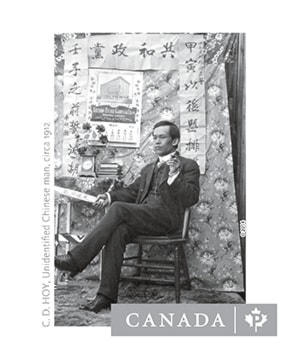Quesnel’s own C.D. Hoy is featured in the 2014 Canada Post stamp collection which highlights the work of Canadian photographers.
This is the second issue in a five-year series on Canadian photography. The collection is a celebration of the works of such master photographers as Edward Burtynsky, Lynne Cohen, Fred Herzog, Michel Lambeth, William Notman and Louis-Prudent Vallee and Quesnel’s Chow Dong Hoy.
Seven stamps featuring iconic photographs were carefully selected with the help of archivists and museum curators and other experts with historical and technical knowledge of photography.
Canada Post contact Barkerville Historic Town, looked through the C.D. Hoy collection and chose an image called Unidentified Chinese Man. A few other photos will be featured in the write up on C.D. Hoy in the annual stamp book released by Canada Post.
Born in 1883 in Guangdong Province in China, Chow Dong Hoy came to Canada in 1902. Traveling from jobs in Vancouver, to Quesnel and Fort St. James, Hoy even started his own trading company which failed. Continuing with various work, he was able to send money home to his family in China. Eventually he returned to Quesnel and Barkerville where he worked as a barber, watch repairman and photographer. After a trip back to China where he married, Hoy returned alone again to Quesnel where he became a storekeeper and photographer. He used an Eastman Land Camera and turned the pictures into postcards that people could send to family and friends far away.
By 1917 he was able to bring his wife over from China and by 1934 he had built a large house in Quesnel, eventually filling it with 12 children. During the 1930s and 1940s he also operated a movie theatre and power company in the nearby town of Wells.
C.D. Hoy’s photographs present a unique record of the coming together of cultures in the Cariboo, while simultaneously providing evidence of cultures in transition.
Hoy’s images are remarkable in that they are not ethnographic studies, nor do they present the subjects as the exotic archetypes of the Mysterious Orient or the Savage West; rather, they are very personal portraits, commissioned by the subjects themselves.
During his time in the gold rush town of Barkerville, Hoy photographed the miners and people from all walks of life, making portraits for them to send home to their families.
A collection of his glass plate negatives was donated to the archives of Barkerville History Town and is now part of a 80-print exhibit on long term loan to the Quesnel and District Museum and Archives. In addition, they are also part of a travelling exhibition that has already been to Vancouver, Hong Kong and is scheduled to be on long term loan to the Overseas Chinese Museum in Guangzhou, China.
Most of Hoy’s photographs are available for viewing on Barkerville Historic Town’s archival collections website at www.barkerville.ca.
“We at the Barkerville Heritage Trust are pleased that Canada Post has chosen to feature the work of an early Chinese pioneer with deep roots in both Barkerville and Quesnel,” CRD director John Massier said.
Hoy’s photographs, including the one chosen by Canada Post Unidentified Chinese Man, are an invaluable record of the rich cultural diversity of B.C.’s Cariboo region between 1909 and 1920.
They are important historical and aesthetic portraits of the Interior’s Aboriginal People, Chinese workers
and Caucasian labourers.
The stamps are available in booklets of 10 and booklets for domestic stamps and booklets of six for U.S. and International denominations.Ask for yours at the Canada Post office in Quesnel.
